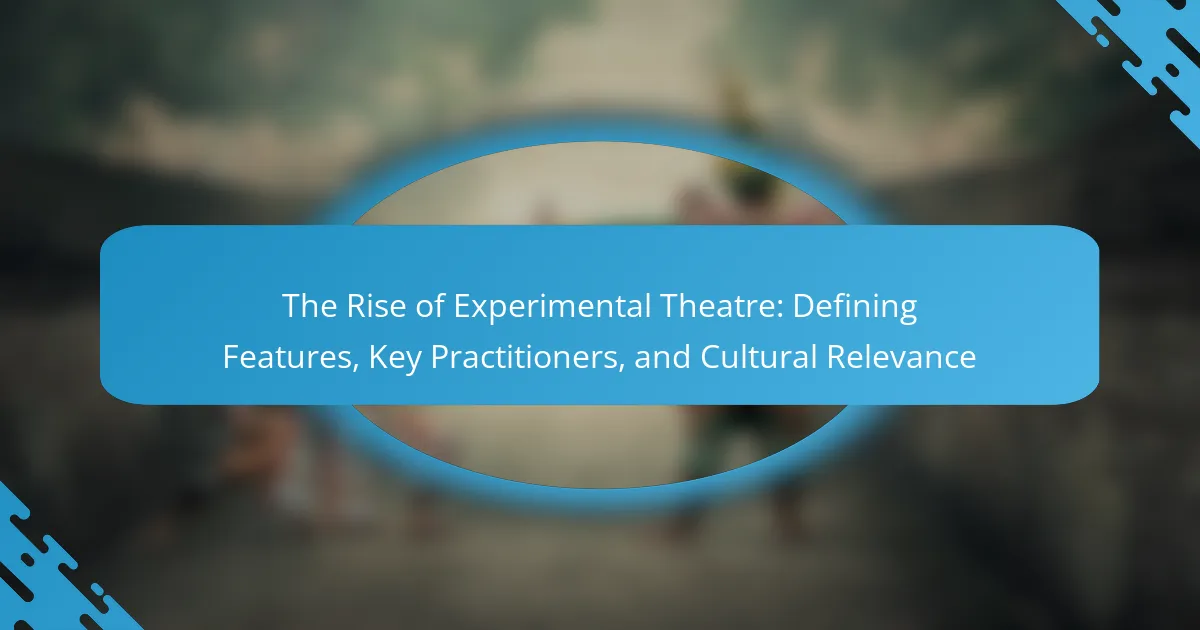Greek theatre originated in the 6th century BCE in Athens, evolving from religious festivals dedicated to the god Dionysus. Key figures in this development include Aeschylus, who introduced the second actor, Sophocles, who added a third actor and enhanced stagecraft, and Euripides, known for his complex characters. The evolution of Greek theatre established foundational elements such as structured dialogue, tragedy, and comedy, which continue to influence modern drama. The theatrical conventions developed during this period, including the use of masks and staging techniques, have left a lasting impact on performance practices today. Overall, the contributions of Greek playwrights and the cultural significance of their works remain integral to the narrative and character development in contemporary theatre.

What is the Evolution of Greek Theatre?
Greek theatre evolved from religious festivals honoring Dionysus. It began in the 6th century BCE in Athens. Initially, performances featured hymns called dithyrambs. These were recited by a chorus. The introduction of an actor by Thespis marked a significant change. Aeschylus later added a second actor, allowing for dialogue. Sophocles introduced a third actor and enhanced stagecraft. By the 4th century BCE, theatre became a major cultural institution. The works of playwrights like Euripides further shaped its development. Greek theatre influenced Roman theatre and continues to impact modern drama.
How did Greek Theatre originate and develop over time?
Greek Theatre originated in the 6th century BCE in Athens. It began as part of the Dionysian festivals honoring the god Dionysus. The performances initially featured hymns called dithyrambs. Over time, these evolved into structured plays. A key figure in this evolution was Thespis, who is credited with introducing the first actor. This innovation allowed for dialogue and character development. By the 5th century BCE, playwrights like Aeschylus, Sophocles, and Euripides further advanced the art form. They introduced complex plots and themes, enriching the theatrical experience. Greek Theatre continued to develop, influencing Roman Theatre and modern drama.
What cultural and historical factors influenced the beginnings of Greek Theatre?
Greek Theatre began as a religious ritual in honor of the god Dionysus. This cultural practice involved music, dance, and storytelling. The festival of Dionysia in Athens was pivotal in its development. It featured competitions for playwrights and performances of tragedies and comedies. The influence of mythology provided rich material for playwrights. Additionally, political factors, such as the rise of democracy in Athens, encouraged public participation in theatre. The use of amphitheaters facilitated large audiences and communal experiences. These elements combined to create a unique theatrical tradition that shaped Western drama.
How did the structure of Greek Theatre change throughout its history?
The structure of Greek Theatre evolved significantly from its origins to the Hellenistic period. Initially, performances took place in open-air spaces, often in natural amphitheaters. These early structures featured a simple circular orchestra for the chorus and a raised platform for actors. Over time, the introduction of the skene, a building used for scenery and actor entrances, transformed the performance space.
By the 5th century BCE, theatres became more elaborate, incorporating tiered seating to enhance audience visibility and acoustics. The Theatre of Dionysus in Athens exemplified this evolution, showcasing a semi-circular design with a capacity of around 17,000 spectators.
During the Hellenistic period, theatres expanded further, often including elaborate decorations and larger skenes. This transition marked a shift from purely religious performances to more diverse theatrical expressions. The structural advancements allowed for greater spectacle and complexity in storytelling, reflecting the changing cultural dynamics of ancient Greece.
What are the key characteristics of Greek Theatre?
Greek Theatre is characterized by its structured format, use of masks, and incorporation of music and dance. The theatre typically featured a circular orchestra where actors performed. It consisted of three main genres: tragedy, comedy, and satyr plays. Greek Theatre emphasized dramatic storytelling and complex characters. The use of masks allowed actors to portray multiple roles and convey emotions. Performances were often held during religious festivals, particularly in honor of Dionysus. The architecture included open-air amphitheaters that enhanced acoustics. Notable playwrights like Aeschylus, Sophocles, and Euripides contributed to its development and legacy.
What role did performance spaces play in Greek Theatre?
Performance spaces were crucial to Greek Theatre as they facilitated public gatherings and performances. These spaces, such as amphitheaters, were designed for optimal acoustics and visibility. The large, open-air structures allowed audiences to engage with performances from a distance. They often featured a circular orchestra where the chorus performed. The elevated seating arrangements enhanced the viewing experience for spectators. Additionally, these spaces were integral to festivals honoring gods, particularly Dionysus. The connection between performance and religious celebration was significant in ancient Greek culture. Historical records indicate that major festivals attracted thousands of attendees, emphasizing the importance of these venues.
How did the use of masks and costumes contribute to the theatrical experience?
The use of masks and costumes significantly enhanced the theatrical experience in ancient Greek theatre. Masks allowed actors to portray multiple characters, facilitating quick role changes. They also amplified voices, making performances more audible to large audiences. Costumes provided visual cues about a character’s status, age, and personality. This helped the audience quickly understand the narrative context. Furthermore, elaborate costumes and masks contributed to the overall spectacle, drawing viewers into the story. Historical records indicate that masks were essential for conveying emotions, as the exaggerated features made expressions visible from afar. Overall, masks and costumes were vital tools that enriched the storytelling and engagement of the audience.

Who were the key playwrights in Greek Theatre?
The key playwrights in Greek Theatre were Aeschylus, Sophocles, and Euripides. Aeschylus is known as the father of tragedy. He introduced the second actor, allowing for dialogue. His notable works include “Agamemnon” and “The Persians.” Sophocles is famous for his innovations in theatrical structure. He added a third actor and introduced painted scenery. His well-known plays include “Oedipus Rex” and “Antigone.” Euripides is recognized for his complex characters and emotional depth. His significant plays include “Medea” and “The Bacchae.” These playwrights shaped the foundations of Western drama. Their works are still performed and studied today.
What contributions did Aeschylus make to Greek Theatre?
Aeschylus significantly contributed to Greek theatre by introducing the second actor, which allowed for dramatic dialogue. This innovation enhanced the complexity of storytelling. He is also known for developing the use of costumes and stage props. Aeschylus wrote over 90 plays, with only seven surviving, including “Agamemnon” and “The Libation Bearers.” His works often explored themes of justice and fate. Aeschylus is credited with elevating the status of playwrights in society. He won many competitions at the City Dionysia festival, showcasing his influence. His contributions laid the groundwork for future playwrights, including Sophocles and Euripides.
How did Aeschylus innovate the use of dialogue in plays?
Aeschylus innovated the use of dialogue in plays by introducing a second actor, which allowed for more dynamic interactions. This development marked a shift from the earlier format, which primarily featured a single actor and a chorus. With the introduction of the second actor, Aeschylus enabled the exploration of conflict and character development through dialogue. His plays featured complex exchanges that deepened the narrative and emotional engagement. Aeschylus’s work, such as “The Persians” and “Agamemnon,” exemplifies this innovation. These plays utilize dialogue to reveal motivations and relationships among characters, enhancing the storytelling experience. Aeschylus’s contributions laid the groundwork for future playwrights, influencing the structure of Western drama.
What themes and styles are prevalent in Aeschylus’s works?
Aeschylus’s works prominently feature themes of justice, fate, and the relationship between humans and the divine. His tragedies often explore the consequences of human actions and the moral dilemmas faced by characters. Aeschylus is known for introducing the concept of a second actor, which allowed for more complex dialogues and interactions. His style includes the use of grand language and elaborate imagery. He frequently employed religious and mythological references to convey deeper meanings. Aeschylus’s plays, such as “Oresteia,” illustrate the evolution of societal norms regarding justice. His works laid the foundation for future playwrights in Greek theatre.
How did Sophocles influence the development of Greek Theatre?
Sophocles significantly influenced the development of Greek theatre through his innovations in playwriting. He introduced the third actor, which allowed for more complex interactions and character development. This innovation expanded the dramatic possibilities of storytelling on stage. Sophocles also enhanced the use of scenery and stage machinery, creating more visually engaging productions. His plays often featured intricate plots and deep character exploration, setting a standard for future playwrights. Notably, he wrote over 120 plays, with only seven surviving, showcasing his prolific contribution. His work laid the groundwork for the evolution of tragedy, influencing playwrights like Euripides and Aeschylus. Sophocles’ emphasis on moral and philosophical themes resonated deeply with audiences, shaping the cultural landscape of ancient Greece.
What innovations did Sophocles introduce in terms of plot structure?
Sophocles introduced several innovations in plot structure. He developed the use of a three-actor system, allowing for more complex interactions. This innovation enabled richer character development and deeper emotional engagement. Sophocles also enhanced the use of dramatic irony, creating tension between characters’ knowledge and audience awareness. He introduced subplots that complemented the main narrative, adding layers to the story. Furthermore, he emphasized character motivation, making actions more relatable and believable. His plays often featured a clear beginning, middle, and end, adhering to a more structured narrative arc. This approach helped shape the evolution of Greek tragedy and influenced future playwrights.
What are the most notable plays written by Sophocles?
The most notable plays written by Sophocles include “Oedipus Rex,” “Antigone,” and “Oedipus at Colonus.” “Oedipus Rex” is a tragedy that explores themes of fate and free will. It is considered one of the greatest works in Western literature. “Antigone” addresses moral conflict and the struggle between individual conscience and state law. It is highly regarded for its powerful themes of loyalty and justice. “Oedipus at Colonus” serves as a sequel to “Oedipus Rex,” depicting Oedipus’s final days and his search for redemption. These plays are foundational to the study of Greek theatre and continue to influence modern drama.
What impact did Euripides have on Greek Theatre?
Euripides significantly transformed Greek theatre by introducing complex characters and emotional depth. He shifted the focus from traditional heroic figures to everyday people. This change allowed audiences to relate more personally to the characters. Euripides also incorporated strong female characters, challenging societal norms of his time. His plays often explored themes of fate, love, and morality, adding layers of complexity. The use of soliloquies became more prominent in his works, enhancing emotional engagement. His influence is evident in the works of later playwrights, including the Roman playwright Seneca. Euripides’ innovative approach laid the groundwork for modern drama.
How did Euripides challenge traditional themes and characters?
Euripides challenged traditional themes and characters by introducing complex, flawed protagonists. He often portrayed women as strong, independent figures, contrary to their typical subservient roles in Greek society. Euripides also questioned the morality of the gods, depicting them as capricious and indifferent. His plays frequently explored human emotions and psychological depth, diverging from the heroic ideals of earlier playwrights. For instance, in “Medea,” he presents a woman driven by passion and vengeance, challenging societal norms. Additionally, Euripides utilized contemporary issues, such as war and social injustice, to resonate with his audience. His innovative characterizations and thematic explorations laid the groundwork for modern drama.
What legacy did Euripides leave for future playwrights?
Euripides left a significant legacy for future playwrights by introducing complex characters and emotional depth. He focused on the psychological motivations of his characters. This approach differed from the more traditional, heroic portrayals seen in earlier Greek tragedies. Euripides often depicted flawed and relatable characters. His works challenged societal norms and questioned moral values. This encouraged later playwrights to explore similar themes in their own writing. Furthermore, he utilized innovative narrative techniques, including the use of prologues and deus ex machina. These techniques influenced the structure of future dramatic works. Overall, Euripides’ emphasis on character development and thematic complexity shaped the evolution of drama.

What is the lasting impact of Greek Theatre on modern theatre?
Greek Theatre has profoundly influenced modern theatre through its foundational elements. The use of dialogue and structured plots originated in Greek plays. This established a framework for storytelling that persists today. Additionally, the concept of tragedy and comedy was introduced by Greek playwrights. Their exploration of complex characters and moral dilemmas remains relevant in contemporary works.
Greek Theatre also pioneered the use of theatrical conventions, such as masks and staging techniques. These elements have evolved but are still integral to theatrical productions. The emphasis on performance as a communal experience can be traced back to ancient Greek festivals. This tradition continues to shape how theatre engages audiences today.
Overall, the lasting impact of Greek Theatre is evident in narrative structure, character development, and performance practices that define modern theatre.
How has Greek Theatre influenced contemporary playwriting?
Greek Theatre has significantly influenced contemporary playwriting through its foundational elements of structure and themes. The use of dramatic structure, including the three-act format, can be traced back to Greek tragedies. This structure helps create tension and resolution, essential in modern plays. Additionally, Greek Theatre introduced complex characters and moral dilemmas, which remain prevalent in contemporary narratives.
Themes such as fate, identity, and the human condition, explored by playwrights like Sophocles and Euripides, continue to resonate today. The use of dialogue and monologues in Greek plays has shaped character development in modern scripts. Furthermore, the incorporation of chorus in Greek Theatre has inspired techniques like breaking the fourth wall in contemporary performances.
These influences highlight the enduring legacy of Greek Theatre in shaping the narrative and structural foundations of modern playwriting.
What elements of Greek Theatre can be seen in modern theatrical productions?
Modern theatrical productions often incorporate elements of Greek Theatre, such as the use of a chorus. The chorus in Greek plays provided commentary and reflection on the action. This element is mirrored in contemporary productions through ensemble groups that enhance storytelling.
Another element is the thematic exploration of tragedy and comedy. Greek Theatre often focused on these themes, which continue to resonate in modern works. Additionally, the structure of plays, including the three-act format, is influenced by Greek dramatic structure.
The use of masks in Greek Theatre has evolved into modern techniques in character portrayal. This can include makeup and costume design that emphasize character traits. Furthermore, the concept of catharsis, where audiences experience emotional release, remains a core aspect of modern theatre.
Lastly, the incorporation of mythological themes is prevalent in both Greek and modern plays. Many contemporary productions draw inspiration from ancient myths, adapting them for modern audiences.
How do modern adaptations of Greek plays reflect current societal issues?
Modern adaptations of Greek plays reflect current societal issues by reinterpreting themes relevant to contemporary audiences. These adaptations often address topics such as gender equality, political corruption, and social justice. For instance, adaptations of works like “Antigone” explore civil disobedience in the face of unjust laws. This mirrors current movements advocating for human rights and social change. Additionally, modern interpretations may incorporate diverse casting to challenge traditional representations and promote inclusivity. This approach resonates with ongoing discussions about race and identity in society. Overall, the relevance of Greek plays is maintained through their ability to engage with pressing contemporary issues.
What lessons can modern theatre practitioners learn from Greek Theatre?
Modern theatre practitioners can learn the importance of storytelling from Greek Theatre. Greek plays often centered around universal themes such as fate, morality, and human experience. These themes resonate with audiences across time and cultures. Additionally, Greek Theatre emphasized the role of the chorus in enhancing narrative and emotional depth. This technique can be adapted to modern performances to create a richer theatrical experience. Furthermore, the use of masks in Greek Theatre allowed for the exploration of character and emotion. This practice encourages modern practitioners to experiment with physicality and representation in their work. Finally, Greek Theatre’s focus on community engagement reminds contemporary artists of the value of audience connection and participation. These lessons from Greek Theatre can enrich modern theatrical practices and deepen audience engagement.
How can the techniques used in Greek Theatre enhance current performance practices?
Techniques used in Greek Theatre can significantly enhance current performance practices. The use of masks in Greek Theatre allows for a heightened expression of character and emotion. This technique can help modern actors convey complex emotions more effectively. Additionally, the chorus in Greek Theatre provides a collective voice that can enhance storytelling. This can be adapted in contemporary performances to create a deeper connection with the audience.
Furthermore, the emphasis on physicality and movement in Greek Theatre encourages actors to explore their bodies as instruments of expression. This focus can improve the overall dynamism of modern performances. Lastly, the integration of music and rhythm in Greek Theatre can inspire current productions to incorporate soundscapes that enrich the narrative. These techniques, rooted in historical practices, offer valuable insights for enhancing the artistry and impact of contemporary theatre.
What best practices from Greek Theatre can be applied today?
Best practices from Greek Theatre that can be applied today include the use of ensemble performance, which emphasizes collaboration among actors. This technique fosters a strong sense of community and shared purpose. Additionally, Greek Theatre often incorporated themes of moral and ethical dilemmas. These themes remain relevant and can provoke critical thought in contemporary audiences.
Moreover, the practice of utilizing a chorus to provide commentary enhances storytelling. This technique engages the audience and deepens their understanding of the narrative. The structure of Greek plays, with clear beginnings, middles, and ends, also serves as a model for effective storytelling in modern theatre.
Furthermore, Greek Theatre emphasized the importance of spectacle and visual storytelling. This focus on aesthetics can enhance audience engagement today. Finally, the exploration of human emotions and experiences in Greek plays resonates with audiences, making these narratives timeless and applicable in modern contexts.
The main entity of the article is Greek Theatre, which evolved from religious festivals honoring Dionysus in the 6th century BCE. The article outlines the origins and development of Greek Theatre, highlighting key playwrights such as Aeschylus, Sophocles, and Euripides, and their contributions to the art form. It explores the structural changes in performance spaces, the use of masks and costumes, and the thematic depth of the plays. Additionally, the lasting impact of Greek Theatre on modern drama and playwriting is examined, emphasizing its influence on narrative structure, character development, and contemporary societal issues.



